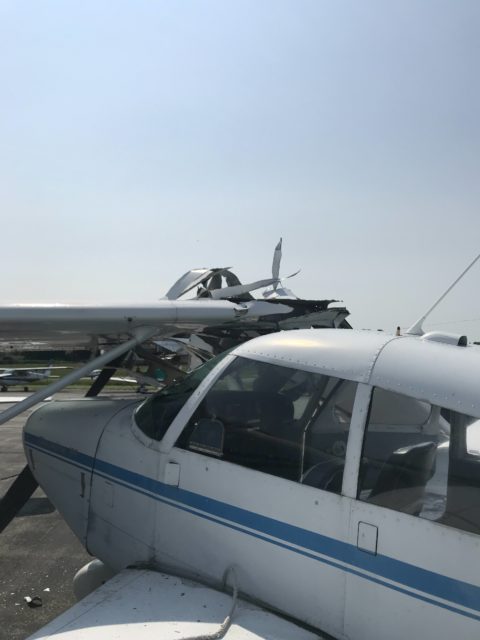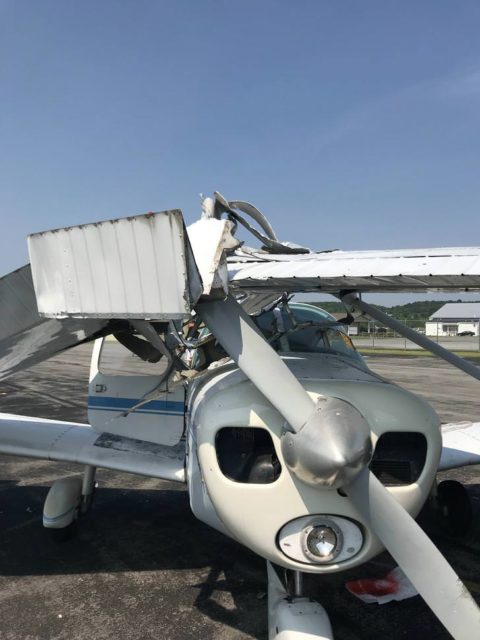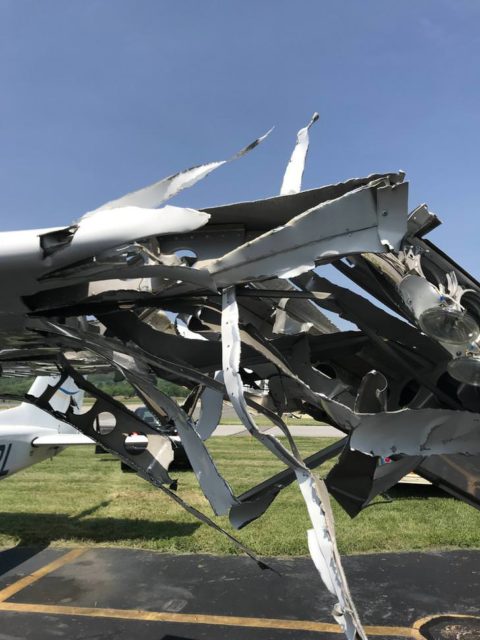Please Keep Your Feet In The Cockpit At All Times
The subject line on Reddit said Don’t start your airplane with your feet outside the cockpit so as you can imagine, I had to click. And having seen the story behind it, I now have to share it with you.
The incident, involving a Piper Cherokee and a parked Cessna 172, took place at Orange County Airport in New York. The Cherokee was uninsured. The poster, jetmech09 is one of the owners of the flight school there who was asked to estimate the damage to the Cessna (owned by one of his partners and used by the flight school). …And, well, I don’t think I can improve on his telling of the chain of events, even though he only quickly typed it on his phone from the scene.
Owner of Cherokee was laying across the seat with his feet on the wing because his battery was dead or something and just wanted to see if it would crank.
It started up at 3/4 throttle. He tried the hand brake and it didn’t work.
Instead of pulling mixture, he tried to grab the rudder pedals with his hand and steer (WTF??? #2).
The left wing hit the right side of the Cessna cowling and pivoted into the left wing of the Cessna.
Sorry if that’s unclear I’m on mobile and working with the insurance company to get a repair estimate.
Now, I can’t quite imagine how someone’s brain can jump from “Uh oh, the brake isn’t working” to “I’m going to use my hands on the rudder pedals to steer”.
Here’s the result:
At the time of posting, he had estimated $57,000 damage to the Cessna and still counting. The Cessna was insured for $50,000. The Cherokee didn’t have insurance. The Cherokee also needs an engine and a left wing but understandably the poster wasn’t all that concerned about that.
jetmech09 posted more details in an aviationmaintenance thread called Let’s talk about complacency giving more details.
My buddy and I run a small flight school / maintenance shop at a small airport. He had his 172 at the tie down area because I had a few airplanes in the shop. He left for a flight and shortly after departure, he texted me “go out to my airplane NOW.” Ok, I go look outside the door towards the ramp–5 sheriffs lit up around his airplane. I couldn’t really see what was going on so I head over.
A Cherokee ran into his 172. Ok, accidents happen. But this one is particularly stupid.
The pilot of the Cherokee hadn’t flown his airplane in about 5 years, so he was on the field trying to get the airplane ready to ferry for an annual (to fly off field because there’s a mechanic around here who’ll do it for $400, but that’s a whole other story). Drain fuel/oil whatever, etc. The battery was dead, of course, so the pilot charged it up.
FOR SOME REASON, and this is the messy part, he was laying across the seats with his feet outside of the door messing around with ???. He decided to bump the starter to see if the engine would turn over while laying down (mistake one–can’t clear prop). Well, it started. He hadn’t set the brake (mistake two). The aircraft started moving forward, so he yanks the hand brake, but SURPRISE, the airplane has been sitting for years and the brake is flat. He never pumped em up, didn’t check em, whatever (mistake three). At this point, the aircraft is moving slowly and the guy panics.
We’re not sure what *exactly* happened, but the throttle was at 3/4 power. I assume while he was scrambling, he hit the throttle moving around in the cockpit (remember he was laying across the seats). Either way, the power settings were up there. On the ramp. Facing other airplanes. With failed brakes. And really no pilot. Instead of grabbing the mixture, the pilot decided to grab the rudder pedals with HIS HANDS and try to steer the airplane (WTF????? BIG mistake #4). Well, that didn’t work out. As he was turning right, unable to see anything, the Cherokee’s left wing hit the left side of my friend’s 172, spinning the aircraft back left and into the R/H wing of the 172–almost cut the wing clear off.
I don’t know how the pilot shut the engine down, but when I got to the ramp, throttle was in, mixture was in, mags & master were off.
Two totaled airplanes. Cherokee didn’t have insurance (mistake #5). Engine is obviously trashed, needs windshields, and the wing separated so I’m assuming that airplane is totaled.
The 172 obviously needs a wing, BUT the prop of the 172 got caught in the cherokee wing as it was turning. I did a VERY quick inspection and it seems like the crank is bent and/or broken. The runout on the prop flange was HORRIBLE. Engine frame twisted, damage to the firewall, etc.
I think it’s very easy to write this all off and call the pilot an idiot, but what it really comes down to is complacency–he’d done it a million times, he knew what he was doing, etc. etc., but there’s always that ONE time. FOLLOW the safety procedures. That’s why they’re there.
He’s lucky as hell he hit an airplane. He’s lucky nobody was on the ramp. He could have killed someone or ran into the fuel farm or a building. He couldn’t see where he was going, with no control whatsoever.
You can read both threads on Reddit: Don’t start your airplane with your feet outside the cockpit and Let’s talk about complacency..











The GOOD outcome is this guy won’t be able to afford to get near a plane again.
But did he ask someone to hold his beer first? :-)
I hope he can’t sue the flight school.
An aircraft that had not been flown in five years?
Was it even airworthy?
I have always been taught that an aircraft MUST carry documentation such as Certificate of registration, Certificate airworthiness, relevant documentation like radio licence- and electronic equipment, weight and balance documents. That sort of paperwork.
It also listed: Insurance certificate and maintenance release.
Some items are more applicable to commercial aircraft but even so, I always thought that insurance was compulsory, just like with a car.
In the early days of my career I used to work for a company that in those days was very big in aerial advertising, “banner towing”.
This was done mainly with Piper Super Cubs.
There was barely any work during the winter, most Pipers were parked outside, tied down.
In the spring the mechanics would do an inspection, a run-up and oil change.They also drained the tanks but overlooked that the fuel pick-up in was not quite at the rear end of the tank.
The PA 18 is a taildragger. That meant that not all accumulated water had been drained from the tank.
The aircraft also had a balance tank in the fuselage.
Result? I took off, the tail came up, the remaining water now was sucked in but the balance tank still fed the engine – that is, until the water reached it. My engine quit when I was (Probably) about 100 feet up in the air. I landed in a field behind the runway. As luck had it, there was a fire gate that was unlocked. I opened it, pulled the airplane back onto the airport (EDLE) and waited for the mechanics.
They pulled the Piper back into the hanger, supported the tail and drained the tanks again, this time properly. There still was nearly half a milk bottle of water in either !
After that, I flew the aircraft again.
So what was this JERK thinking of? Taking an aircraft after FIVE years? nisured? His licence should be pulled (if even he has one). And who will pay for the damage to the 172?
Disgusting !
Rudy — the story notes that the plane was to be taken to an inspection; when I knew the US aviation regulations (40 years ago), there was a ferrying-to-inspection exception to the limits on time/age (or at least time — school airplanes (being commercial?) had to have 100-hour checks, which were done at another field, as well as annuals). Most insurance in the US is regulated by the states, many of which do NOT require it for automobiles; I suspect the states’ authority is superseded by the national govt., whose approach is probably a mix of we-can’t-be-bothered and the-people-who-care-will-make-a-scene-if-we-require-insurance.
But yes, this character sounds like he’s preparing for a Darwin Award nomination. I was also reminded of an old comedy sketch about a mason trying to let down a barrel-load of bricks via pulley. (Hint: the loaded barrel weighed more than he did.)
Every state in the US that I am familiar with (which is many) requires insurance on automobiles, with large fines if you don’t have it – some don’t check for it very often, but they require it.
What the minimum required level of insurance is is a very different story – many don’t require over $10,000, so a driver they hit can still be out alot.
In this story, since we already know he wasn’t following many rules, it would not be surprising to find out that he wasn’t following rules on insurance either!
On a more comical note, this reminds me of another incident – actually two. It happened in the late ‘seventies.
A charter company had a job, an exchange of crews from an oil rig.
It was New Year’s Eve.One crew was to be flown by helicopter to a French airport, it could have been Quimper.
The new crew was to be flown by this charter from Rotterdam, the relieved crew back to the same airport for heli transfer to the rig.
The charter company was an air ambulance company and owned two Cessna Titans, piston-engined twins.
They were based at Schiphol, Amsterdam.
A general aviation inspector from the Rijksluchtvaartdienst, the Dutch CAA, decided to join this flight for an inspection.
All passenger seats had been booked. As the inspector was fully qualified, it was decided to leave the co-pilot at home. The inspector acted as first officer.
During the ferry to Rotterdam a mechanical problem developed.
The destination – Quimper? – would close at midnight sharp. The pressure was on to get the Titan fixed in time.
Another Rotterdam-based company was operating charters with French-built Corvette business jets.
At twice the speed, they were in a good position to take over this charter.
Unknown to the Titan crew, the customer was approached with the offer to substitute the piston twin with a jet.
Anticipating the go-ahead, the Corvette crew contacted Quimper, informed them of the expected change of aircraft and requested jet A1 on arrival.
At the very last moment, the Titan was repaired. The crew were totally unaware of the other company’s attempt to “poach” their charter.
They arrived at the French airport less than 15 minutes before closing time. It caused lots of pressure. The captain went to the reporting office (the one with the big yellow sign with the big black “C”) to quickly fulfill the formalities, the first officer occupied himself with the refueling.
A bowser arrived. All that he knew was that jet fuel had been requested for this flight. The bowser had two compartments, one for AVGAS 100LL, the other for Jet A1.
You guess it: Looking at his request, the flight and the words “Turbo charged” on the engine nacelles, he filled the tanks with jet fuel.
The co-pilot, the man from the CAA, in the meantime had done the pre-flight checks, supervised the boarding and quickly, in the dark, signed the sheet which showed the correct quantity. It was now minutes before closure of the airport, doors were closed, engines started, ATC clearance received and checklist read. He completely missed the “Jet A1” on the fuel receipt.
The run-up was normal, taxi to the runway short, take-off clearance instant. They must have been on the last bits of avgas in the fuel lines.
One engine failed, followed immediately by the other.
As luck had it, a controller in the tower noticed the aircraft going down just as he was switching off the lights.
A New Year’s party was just starting, nearly all the members of the emergency services were there.
The captain handled the emergency well. He aimed for a dark area ahead and landed in a cemetery !
There were no serious injuries but the aircraft was a write-off.
The connection with the article in “Fear of Landing”?
An investigation found that under the circumstances the accident had actually been “in the making” from tandhe beginning, starting with the mechanical problem, the competing company that had offered the Corvette not cancelling the request for jet fuel when the Titan was ready. This was a contributing factor.
The other factor was the bowser with two compartments for avgas and Jet A1. Nozzles for overwing refueling with jet fuel now have a larger diameter and will not fit the filling opening for avgas.
This is now standard practise, as a direct result of this accident.
BUT:
A few months later the same crew, flying the second (surviving) Titan were at Hannover, Germany.
It was during the air show. Departures were given a tight slot, missing it would mean not being allowed to depart.
Only one runway was designated for the departures.
The taxiway was filled with aircraft, the crews anxiously looking at their watches.
Along the taxiway, in the grass, was an area where light aircraft were parked.
The pilot of one of them could not get his engine running and his battery was running flat.
In desperation he got out. No, he.was not lying on the seat, he was outside trying to get the engine running by swinging the prop.
The engine caught and with the throttle open started to move. The parking brake probably had not been set properly, the wheels not chocked. The pilot jumped aside, tried to stop his aircraft by holding a wing. tip.
It did not stop, it continued to roll but swung and headed now straight onto the taxiway and into the path of the Titan which had nowhere to go.
The light aircraft, engine on high power, ploughed into the right wing and engine of the Titan.
After that event, the Dutch CAA prudently abandoned the practice of inspectors acting as crew members on commercial flights.
Both stories.are absolutely true.
My jaw just fell open. Wow!
Chip,
It sounds like the comedy sketch involved two characters, both with bowler hats, one fat with a toothbrush mustache, the other thin and given to crying when he made yet another silly mistake>
Rudy: the version I know involved just one person, which is why it was so catastrophic — but it does have some of that air about it.
That’s a bizarre collection of errors. I’m surprised that differentiated nozzles weren’t already a thing given the variety of incompatible fuels, but apparently Europe didn’t then have the automotive example of the US — where smaller nozzles and filler pipes appeared in 1973 to ensure that cars that would be hurt by leaded gasoline only received unleaded. (Wikipedia tells me Europe didn’t start banning lead until the 1980’s.)